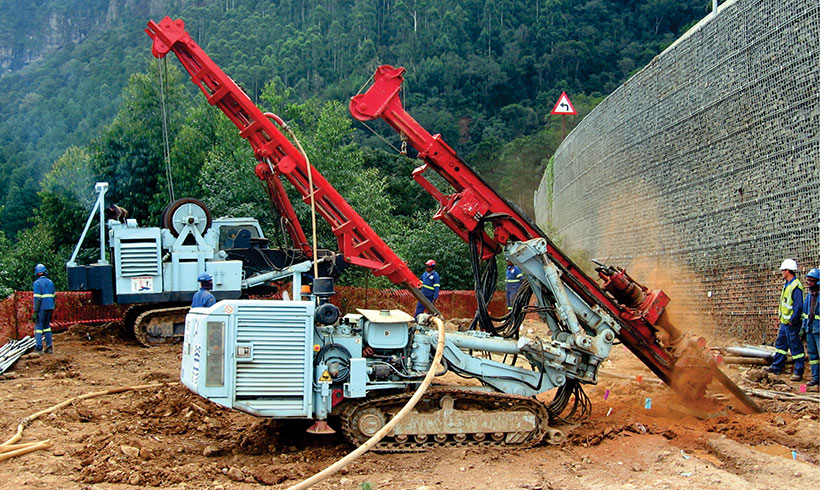Some Known Details About Geotechnical Engineering For Construction Projects
Table of ContentsHow Geotechnical Engineering For Construction Projects can Save You Time, Stress, and Money.What Does Geotechnical Engineering For Construction Projects Do?How Geotechnical Engineering For Construction Projects can Save You Time, Stress, and Money.The Ultimate Guide To Geotechnical Engineering For Construction ProjectsFascination About Geotechnical Engineering For Construction ProjectsUnknown Facts About Geotechnical Engineering For Construction Projects
These functions must be examined by geotechnical designers to forecast their activities under various conditions., making this evaluation required.A geotechnical designer will certainly take a look at soil to determine the bearing capability of the earth and recommend correct structure types, such as shallow structures, deep structures like piles, or specialized services like floating structures for soft soils. Comprehending the attributes and activities of dirt and rock, along with just how they communicate with constructions that have been erected on or within them, is among the main descriptions for why geotechnical engineering is essential.
In addition to structural planning and building and construction, geotechnical engineering is likewise essential to the repair and upkeep of pre-existing structures. Age-related deterioration or extra issues can influence a structure's security and effectiveness. Ecological defense is accomplished via geotechnical engineering. Competence in air, water, and dirt high quality upkeep is used by geotechnical designers to lessen the unfavorable results of projects.
To sum up, geotechnical design is an important self-control that protects the resilience and honesty of civil facilities. Geotechnical engineers contribute to making structure projects reliable all over the globe by comprehending the practices of earth materials and applying ideal preparation techniques.
The Main Principles Of Geotechnical Engineering For Construction Projects
By taking a look at dirt, rock, and subsurface conditions, geotechnical engineers give vital understandings that aid in the style, construction, and upkeep of structures and framework.

10 Easy Facts About Geotechnical Engineering For Construction Projects Shown
Laboratory screening: Establishing the homes of dirt and rock. A number of top-level building jobs have efficiently made use of geotechnical design to ensure their security and safety and security.

As a leader in geotechnical engineering, BECC Inc. is committed to providing ingenious and effective remedies that satisfy the greatest standards of top quality and security. For more details on exactly how BECC Inc. can support your following construction job, call us today and allow us assist you develop on strong ground.
William Rankine, an engineer and physicist, created a different to Coulomb's planet stress concept. Albert Atterberg established the clay uniformity indices that are still used today for dirt classification. In 1885, Osborne Reynolds identified that shearing causes volumetric dilation of dense products go to my site and contraction of loosened granular materials. Modern geotechnical engineering is claimed to have started in 1925 with the publication of Erdbaumechanik by Karl von Terzaghi, a mechanical engineer and rock hound.
Geotechnical Engineering For Construction Projects Can Be Fun For Everyone
Terzaghi additionally developed the framework for theories of bearing capacity of foundations, and the theory for prediction of the price of negotiation of clay layers due to loan consolidation. Afterwards, Maurice Biot fully established the three-dimensional soil loan consolidation theory, prolonging the one-dimensional model previously developed by Terzaghi to extra general hypotheses and introducing the set of standard formulas of Poroelasticity.
Geotechnical engineers explore and identify the residential properties of subsurface conditions and products.
A Biased View of Geotechnical Engineering For Construction Projects
Geologic mapping and interpretation of geomorphology are typically completed in examination with a rock hound or design rock hound. Subsurface expedition generally entails in-situ screening (for instance, the typical infiltration test and cone penetration examination). The digging of examination pits and trenching (specifically for situating faults and slide airplanes) may likewise be used to discover regarding soil conditions at deepness. Still, they are often made use of to permit a rock hound or designer to be lowered into the borehole for straight aesthetic and manual evaluation of the soil and rock stratigraphy. Various soil samplers exist to meet the needs of various design tasks. The common infiltration examination, which makes use of a thick-walled index split spoon sampler, is the most typical way to accumulate disrupted examples.

If the user interface in between the mass and the base of an incline has an intricate geometry, slope security evaluation is hard and numerical solution approaches are needed. Commonly, the user interface's specific geometry is unknown, and a streamlined interface geometry is presumed. Finite slopes require three-dimensional versions to be assessed, so most inclines are assessed thinking that they are definitely large and can be stood for by two-dimensional models.
The Buzz on Geotechnical Engineering For Construction Projects
Creating the style based on a working theory of habits prepared for under the most likely problems. Choice of quantities to be observed as building earnings and calculating their prepared for worths based on the working hypothesis under the most undesirable conditions.
Dimension of quantities and evaluation of actual problems. Layout modification per real problems The observational approach appropriates for building and construction that find out here has currently started when an unforeseen development takes place or when a failure or accident looms or has already occurred. It disagrees for tasks whose layout can not be modified throughout construction.
Comments on “Geotechnical Engineering For Construction Projects Fundamentals Explained”